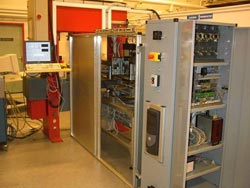Additive Manufacturing of metal products with functionally graded material composition

As a result of a multi-million Euro project, a high speed Metal Printing Process (MPP) for the production of metal products with functionally graded materials has been developed.
Custom-Fit is an industry led project funded by the EC under Sixth Framework Programme, with the aim of creating a fully integrated system for the design, production and supply of individualised products using Rapid Manufacturing technologies. One objective of the project is to develop new production systems based on Additive Manufacturing technology for the manufacturing of customised products. The Metal Printing Process (MPP) is one of the processes developed under the project by the Norwegian research institute SINTEF.
MPP aims to become the equivalent of a high speed 3D-printer that produces three-dimensional, solid metal, freeform objects directly from powder materials. This technique is based on the process principles of xerographic printers, (such as for example laser -or LED- printers) and the proven technology of conventional powder metallurgy. The MPP process approach uses the same fundamental principles to build solid objects on a layer-by-layer basis. Layers of powder materials are generated by attracting different metal- and/or ceramic powders to their respective position on a charged pattern on a photoreceptor by means of an electrostatic field. The attracted layer is transferred to a punch and transported to the consolidation unit where each layer of part material is sintered onto the previous by pressure and heat. The procedure is repeated layer-by-layer until the three-dimensional object is fully formed and consolidated.
MPP has the ability to print different powders within the same layer and progressively change from one material to another, i.e. producing a functionally graded material. In addition to this, MPP has been developed to work with any commercially available powders. This ability to fabricate products with a wide range of materials incorporated opens the possibility to produce unique material combinations and microstructures.
This new technology opens up a whole new world for producing metal products with better mechanical structure. Roald Karlsen, senior scientist in SINTEF who is heading the development of MPP, says, “The areas of application are only limited by our imagination. When the technology is fully available new applications and needs will arise. Some relevant applications for the MPP might be: production of customized orthopedic implants with functionally graded properties, fabrication of spare parts on demand, tools with conformal cooling channels and embedded sensor technology, high temperature fuel cells, micro-parts from nano-scale powders, etc.”
About Custom-Fit:
Custom-Fit is an industry led project to investigate the possibility of moving towards knowledge based manufacturing and customised production through integration of knowledge in Rapid Manufacturing, Information Technology and Material Science. Funded under the Sixth Framework Programme, the project involves 30 partners from around Europe. The aim is to create a fully integrated system for the design, production and supply of individualised products. It has targeted product for implementing the new technology, including motorcycle seats, helmets, implants and prosthesis.
For all media enquiries, please contact:
Suny Martínez or Luisa Marín
AIJU
Ingeniería de Producto y Ensayos
Avda. de la Industria, 23
03440 IBI (Alicante) Spain
Telephone number: +34 965554475
Fax number: +34 965554490
e-mail: customfit@aiju.info
Media Contact
All latest news from the category: Process Engineering
This special field revolves around processes for modifying material properties (milling, cooling), composition (filtration, distillation) and type (oxidation, hydration).
Valuable information is available on a broad range of technologies including material separation, laser processes, measuring techniques and robot engineering in addition to testing methods and coating and materials analysis processes.
Newest articles

Parallel Paths: Understanding Malaria Resistance in Chimpanzees and Humans
The closest relatives of humans adapt genetically to habitats and infections Survival of the Fittest: Genetic Adaptations Uncovered in Chimpanzees Görlitz, 10.01.2025. Chimpanzees have genetic adaptations that help them survive…

You are What You Eat—Stanford Study Links Fiber to Anti-Cancer Gene Modulation
The Fiber Gap: A Growing Concern in American Diets Fiber is well known to be an important part of a healthy diet, yet less than 10% of Americans eat the minimum recommended…

Trust Your Gut—RNA-Protein Discovery for Better Immunity
HIRI researchers uncover control mechanisms of polysaccharide utilization in Bacteroides thetaiotaomicron. Researchers at the Helmholtz Institute for RNA-based Infection Research (HIRI) and the Julius-Maximilians-Universität (JMU) in Würzburg have identified a…



